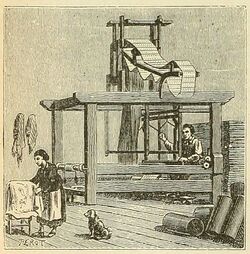Jacquard loom (nonfiction): Difference between revisions
No edit summary |
No edit summary |
||
| (One intermediate revision by the same user not shown) | |||
| Line 3: | Line 3: | ||
The loom is controlled by a "chain of cards", a number of punched cards, laced together into a continuous sequence. Multiple rows of holes are punched on each card, with one complete card corresponding to one row of the design. Chains, like Bouchon's earlier use of paper tape, allow sequences of any length to be constructed, not limited by the size of a card. | The loom is controlled by a "chain of cards", a number of punched cards, laced together into a continuous sequence. Multiple rows of holes are punched on each card, with one complete card corresponding to one row of the design. Chains, like Bouchon's earlier use of paper tape, allow sequences of any length to be constructed, not limited by the size of a card. | ||
It is based on earlier inventions by the Frenchmen Basile Bouchon (1725), Jean Baptiste Falcon (1728) and Jacques Vaucanson (1740). | It is based on earlier inventions by the Frenchmen Basile Bouchon (1725), Jean Baptiste Falcon (1728), and [[Jacques de Vaucanson (nonfiction)|Jacques Vaucanson]] (1740). | ||
The Jacquard head used replaceable punched cards to control a sequence of operations. It is considered an important step in the history of computing hardware. The ability to change the pattern of the loom's weave by simply changing cards was an important conceptual precursor to the development of computer programming and data entry. | The Jacquard head used replaceable punched cards to control a sequence of operations. It is considered an important step in the history of computing hardware. The ability to change the pattern of the loom's weave by simply changing cards was an important conceptual precursor to the development of computer programming and data entry. | ||
| Line 15: | Line 15: | ||
== In the News == | == In the News == | ||
<gallery | <gallery> | ||
File:Ishango bone.jpg|Ishango bone used as shuttle in Jacquard loom, [[Computation (nonfiction)|generates floating point numbers]]. | File:Ishango bone.jpg|Ishango bone used as shuttle in Jacquard loom, [[Computation (nonfiction)|generates floating point numbers]]. | ||
File:A la mémoire de J.M. Jacquard.jpg|link=Joseph Marie Jacquard (nonfiction)|[[Joseph Marie Jacquard (nonfiction)|Joseph Marie Jacquard]] looks good in silk. | File:A la mémoire de J.M. Jacquard.jpg|link=Joseph Marie Jacquard (nonfiction)|[[Joseph Marie Jacquard (nonfiction)|Joseph Marie Jacquard]] looks good in silk. | ||
| Line 22: | Line 22: | ||
== Fiction cross-reference == | == Fiction cross-reference == | ||
* [[A Computer for Yarn]] - short poem | |||
* [[Forbidden Ratio]] - Supervillain with grudge against [[Computation (nonfiction)|all things computational]], including Jacquard looms. | * [[Forbidden Ratio]] - Supervillain with grudge against [[Computation (nonfiction)|all things computational]], including Jacquard looms. | ||
* [[Gnomon algorithm]] | |||
* [[Gnomon Chronicles]] | |||
* [[Herman Hollerith]] - "the Card Man", "the Ticketologist", etc. | * [[Herman Hollerith]] - "the Card Man", "the Ticketologist", etc. | ||
| Line 30: | Line 33: | ||
* [[Computer science (nonfiction)]] | * [[Computer science (nonfiction)]] | ||
* [[Computation (nonfiction)]] | * [[Computation (nonfiction)]] | ||
* [[Jacques de Vaucanson (nonfiction)]] | |||
* [[Herman Hollerith (nonfiction)]] | * [[Herman Hollerith (nonfiction)]] | ||
* [[Joseph Marie Jacquard (nonfiction)]] | * [[Joseph Marie Jacquard (nonfiction)]] | ||
External links | == External links == | ||
* [https://en.wikipedia.org/wiki/Jacquard_loom Jacquard loom] @ Wikipedia | * [https://en.wikipedia.org/wiki/Jacquard_loom Jacquard loom] @ Wikipedia | ||
Latest revision as of 06:34, 18 November 2020
The Jacquard loom is a mechanical loom, invented by Joseph Marie Jacquard, first demonstrated in 1801, that simplifies the process of manufacturing textiles with such complex patterns as brocade, damask and matelasse.
The loom is controlled by a "chain of cards", a number of punched cards, laced together into a continuous sequence. Multiple rows of holes are punched on each card, with one complete card corresponding to one row of the design. Chains, like Bouchon's earlier use of paper tape, allow sequences of any length to be constructed, not limited by the size of a card.
It is based on earlier inventions by the Frenchmen Basile Bouchon (1725), Jean Baptiste Falcon (1728), and Jacques Vaucanson (1740).
The Jacquard head used replaceable punched cards to control a sequence of operations. It is considered an important step in the history of computing hardware. The ability to change the pattern of the loom's weave by simply changing cards was an important conceptual precursor to the development of computer programming and data entry.
Charles Babbage knew of Jacquard looms and planned to use cards to store programs in his Analytical engine.
In the late 19th century, Herman Hollerith took the idea of using punched cards to store information a step further when he created a punched card tabulating machine which he used to input data for the 1890 U.S. Census.
Punched cards remained in use in computing up until the mid 1980s.
In the News
Ishango bone used as shuttle in Jacquard loom, generates floating point numbers.
Joseph Marie Jacquard looks good in silk.
Fiction cross-reference
- A Computer for Yarn - short poem
- Forbidden Ratio - Supervillain with grudge against all things computational, including Jacquard looms.
- Gnomon algorithm
- Gnomon Chronicles
- Herman Hollerith - "the Card Man", "the Ticketologist", etc.
Nonfiction cross-reference
- Charles Babbage (nonfiction)
- Computer science (nonfiction)
- Computation (nonfiction)
- Jacques de Vaucanson (nonfiction)
- Herman Hollerith (nonfiction)
- Joseph Marie Jacquard (nonfiction)
External links
- Jacquard loom @ Wikipedia


